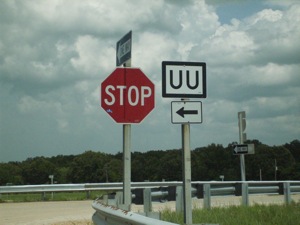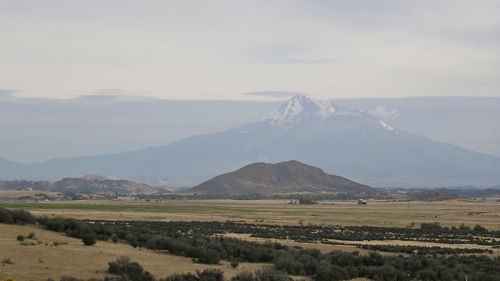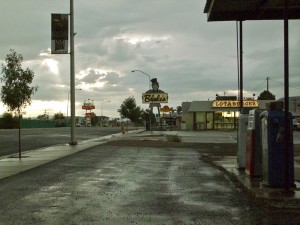Mt. Shasta in the distance, as seen from a rest area off Interstate 5 near Gazelle, California.
Category Archives: Road trips
Road trip: Salem to Portland to Salem
On the drive up to Portland, we listened to the end of the audiobook we had started the day before, A Damsel in Distress by P. G. Wodehouse. We got to the place where I was going to attend a Sacred Harp singing convention, and the book wasn’t quite done yet. We sat there in the car and listened for ten minutes, and the book wasn’t quite done yet. “The final chapter,” said the narrator, and Carol said, “Let’s listen to the last chapter on the drive home.” So we stopped the recording, and I got out to go sing for a few hours.
Carol came to pick me up at three, and we went for a walk with two friends, A— and N—. We took a walk in a park, and A— and I talked about Unitarian Universalism while N— and Carol talked about ecological pollution prevention.
From there, Carol and I drove across the Broadway Bridge and parked near Union Station, a big McKim, Mead, and White building. We walked into the station to use the bathrooms, and it is still quite grand, with big wooden benches (Wikipedia has a nice panoramic photo), and a dozen trains a day passing through or terminating there.
We walked around, and wound up at Powell’s Books. Of course we wound up at Powell’s Books; it’s the kind of place that exerts a gravitational force on people like us. Powell’s exerted a gravitational force on a great many people this evening, and I was almost distracted from the books by the truly excellent people watching. But I exerted self discipline, went and found half a dozen books to buy, and went to have a cup of coffee. The coffee shop in Powell’s was packed, but Carol had saved me a chair. Next to me, a young man studied for the Graduate Record Exams. Across the table, a middle-aged man read some obscure book and barely sipped a cup of coffee. On the other side of Carol, two older men played speed chess.
I half-watched the chess players for a while: White played e4 and bam! hit the button of the clock. Black played e5 and bam! bam! bam! hit the clock three times (he favored the three bam clock gambit). White unwrapped a sandwich as he brought his knight out to f3 and bam! hit the clock. Black immediately played his knight to c6 and bam! bam! bam! White shot his bishop out to b5 and took a bite of sandwich, then remembered that he had to hit the clock and bam! But I don’t play chess any more, and my attention wandered back to the book I was reading.
We walked back to the car, and as soon as we got back on the freeway we played the last chapter of the audiobook. It all ended satisfactorily, as we knew it would, but it was funny enough, and unexpected enough, to keep us listening to the very end.
Road trip: San Mateo to Salem
We left San Mateo at eleven o’clock, and not long after noon we had left behind the crazy traffic and dense population of the Bay area. We got off the freeway, drove through orchards of walnut and pomegranate trees, and stopped for lunch in the small town of Winters. Carol had a perfect food experience: shrimp salad served on fiesta ware on a cheerful Mexican tablecloth.
I had ever driven through the far northern part of California. The freeway left the flat agricultural lands of the Central Valley, wound up through savannah with live oaks and grasses so dry they were whitish-gold, and into the foothills of the Cascade Range. And there was Mount Shasta, impossibly high, its peak hidden in a cloud. The freeway wound past and over Lake Shasta; but I was driving and decided I had better not look too much or we would be down that steep slope and in those blue lake waters way down below the roadway.
At dinner time we stopped in Grants Pass, Oregon, and ate at Shari’s, a restaurant chain of the Pacific Northwest. I have learned to be skeptical of pie purchased near interstate highways, but Shari’s served astonishingly good pie: Marionberry pie with no sugar added, a crust that was light and flaky.
We arrived in Salem at eleven o’clock, twelve hours after leaving home, with no energy for anything except going to bed.
A rural moment
Camp Meeker, California
The retreat center I’m staying at for a couple of days is in the middle of second growth redwood woodlands. This morning, I walked around a bend in a trail , and there were two mule deer (Odocoileus hemionus) standing in the middle of the trail They both froze and looked at me, although they were obviously not particularly afraid to see a human being. I froze and looked back at them. The three of us stood there frozen for four or five minutes until the mule deer decided that I was either not a threat, or stupid, or both. They twitched their big ears, and started browsing again.
They were bending their heads down and eating something that lay on the path. There was no greenery for them to browse on; all I could near them see was old redwood cones; so I couldn’t figure out what it was they were eating. I watched their jaws move sideways as they chewed. Little bits of stuff fell out of the side of their mouths as they ate. They were not very attractive eaters.
At last I got bored, and started walking again. They looked at me as if surprised that I was moving, and then bounded away in a leisurely fashion. When I got to the place where the deer had been, I saw what it was they had been eating: acorns from the tan bark oaks (Lithocarpus densiflorus or, according to some taxonomists, Notholithocarpus densiflorus). The bits of stuff I had seen falling out of the sides of their mouths were bits of the outer husk of the acorns.
Roadtrip: Needles to El Cajon, California
I left Needles, that “miserable place,” early in the morning. It was hot already. I drove south on U.S. 95, through the hot, dry, bleak Colorado desert. This is a two-lane paved road that I would not want to drive during a rain storm; there are no culverts (not that I saw, anyway) and the road dips down to meet every dry wash.
Bleak as it was, the desert scenery was spectacular: stark, forbidding mountains rising up out of the sand plains studded with creosote bushes. After more than an hour of driving, I began to pass side streets, and I began to see small houses here and there in the desert. A sign told me when I reached the city limits of Twentynine Palms, population nearly thirty thousand.
I stopped at the visitor’s center for Joshua Tree National Park, and walked around the Oasis of Mara. It was disappointing: no open water (the water table subsided some years ago after seismic action in the nearby Pinto Mountains), and fewer than twenty nine palm trees. But there were Gambrel’s Quail hiding under the low mesquites, and a pair of Prairie Falcons perched in one of the palms.
From Twentynine Palms, I headed south through the park. The Joshua Trees that give the park its name made me smile. They almost look as if they might start talking to you.
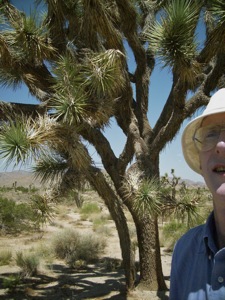
The cholla cactus seem to have personalities, too. Even though you know the lightest touch would be enormously painful, they look almost as if they wanted you to cuddle them.
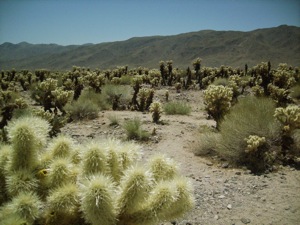
The tall, twisted octillo with its tiny leaves, the mesquite trees, the fan palms: all these amazing plants growing in a very unpromising environment. The birds are amazing too. I stopped at Cottonwood Springs, and even though it was the hottest part of the day, the birds were cheerful because of the seeping water. But the sun was too hot for me; I wanted to stay longer, but I was getting a heat headache, and drove on.
The rest of the drive merely took me deeper and deeper in the urban and suburban sprawl that stretches along the Pacific rim of California. I’m not really ready to stop, but here I am in El Cajon, just outside of San Diego, at the end of my 3,200 mile journey.
Roadtrip: New Mexico, Arizona, and California
This morning I took a side trip to El Malpais National Monument, which lies just to the south of Grants, New Mexico. I didn’t really go to see the lava flows which give El Malpais (“the badlands”) its name; I went to walk in the high desert, take some photographs, and maybe see some birds. I managed to do all three. You’ll have to take my word for the walking, but here’s a photograph of the lava flows (they’re the dark areas down in the valley), as seen from the top of Sandstone Bluffs:
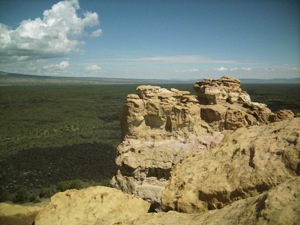
And I saw some birds, too: Black-Chinned Hummingbirds, Scott’s Orioles, Pinyon Jays, Cassin’s Kingbirds, and several other desert-dwelling birds that I had never seen before.
While I sat at the ranger station admiring the hummingbirds and orioles coming to the hummingbird feeder, I heard thunder in the distance. Not long after I started driving, it started raining. I drove through rain from Grants to Gallup. I stopped in Gallup to get lunch and gas, and while I was eating lunch there was a real downpour. I ran out to the car when the rain let up a little, and drove through streets that were several inches deep in muddy brown water. This is insane, I thought, but I was on a tight schedule, so I got on the freeway and drove slowly through the rain. Pretty soon it let up, but I drove through occasional light showers for most of the rest of the day.
I decided I didn’t want to spend any money in Arizona, because of the ridiculous immigration law that the state legislature passed. While I’m sure Arizona will never notice the loss of my paltry travel dollars, I felt better knowing that I had not bought any gas or food in the state. Unfortunately, Arizona is in such tough financial shape that they have closed all the highway rest areas, so somewhere around Flagstaff where there are trees, I found a place by the side of the road where I could pee.
I arrived in Needles, California, at about 7:30. When I opened the door of the car, the air was unbelievably hot. It was so hot and dry that my eyeballs kind of hurt; and every once in a while, a gust of hot wind coming off the desert would make it feel even hotter. According to the National Weather Service, at 6:56 p.m. it was 105 degrees; and last night, the low temperature was 90 degrees.
In spite of the heat, I walked the few blocks from the motel to downtown Needles. The air was so dry, I could feel the moisture being sucked out of my mouth and nose. Not much was happening in downtown Needles; the main activity seemed to be around the BNSF (Burlington Northern Santa Fe) railroad yards, where dozens of cars and pickup trucks were parked. A few people were out walking around, a few cars passed by, but mostly the town was empty. The cartoonist Charles Schulz, who drew the “Peanuts” cartoon, lived here for a few years when he was a child, and his biographer David Michaelis writes:
By day, the sun broiled the vast playa above the town — 120 degrees in the shade of a cottonwood tree was normal for Needles in summer. Most winter nights, the translucent air turned the dry gullies into such iceboxes that he [Schulz] could hear rocks cracking in the cold. In May and September the old wooden tinderbox of a schoolhouse was frequently shut to protect the children from heatstroke. Such little rain as fell came briefly and violently, blasting flash floods out of nowhere.
Needles, [Schulz] decided, was a “miserable place.”
I bought a copy of the Needles Desert Star, “Established in 1888, serving the community of Needles for more than a century.” I learned that the city attorney has been holding training sessions on Robert’s Rules of Order for the members of the city council and various boards; this seems a good plan, and I can think of several communities that should try this sort of thing. Tribal elders gave blessings in the Mohave language to a new park project being built with America Recovery and Reinvestment Act money. And city council members held a meeting to address the sale of the local hospital. In 1983, Charles Schulz’s “Peanuts” was syndicated in its two thousandth newspaper, in Needles, California (Michaelis, p. 531), but I did not find any comic strips at all today’s edition of the Needles Desert Star.
Roadtrip: Oklahoma, Texas, and New Mexico
Soon after I left Elk City, Oklahoma, I saw my first sagebrush by the side of the highway. Agricultural fields increasingly gave way to grazing lands. I’m now in the West.
For the past three days, I’ve eaten at an all-you-can-eat Chinese buffet each night for dinner. Each of these buffets featured some kind of melding of Chinese and American cuisine. The large buffet in Elk City featured french fries, “fried green beans” (a sort of tempura), and “hot buttered potatoes,” alongside the stir-fried vegetables and the fried spring rolls. Here in Grants, New Mexico, at the “Asian Buffet,” I could have had “jalapeno chicken (spicy)” had I wished. None of these buffets offered any kind of tofu dish.
The best meal in roadside restaurants in the middle of America is always breakfast. This morning, I ate at the Elk City Cafe. The waitresses wore t-shirts, jeans, and heavy make-up, and called me “sweetheart” — waitresses have called me “hon” before, but being called “sweetheart” was new to me. The over-easy eggs were perfectly cooked, the bacon was think and tasty, the oatmeal was not watery as it had been in Connecticut nor chunky as it had been in Pennsylvania but exactly the right consistency. The home fries were a little too greasy, but the toast was warm and buttery.
I wanted to take a long walk, to work off some of the grease I’ve eaten today, but it started raining during dinner — with thunder and flashes of lightning — and hasn’t really let up since, and now it’s getting dark. Instead of walking, I drove down the historic route of the famous Route 66 in Grants and looked at the strip:
Grants, New Mexico, looking from an abandoned gas station towards Lotaburger, during a rain storm.
Roadtrip: Missouri and Oklahoma
It was hot and humid yesterday when I arrived in Marshfield, Missouri. I went to bed early so I could get up early when it was cool enough to take a long walk.
I was out the door of the bed and breakfast at a quarter to seven. It was already in the high seventies, and the dew point couldn’t have been much lower than that. I walked up Clay street, across the one line railroad over which I’d seen three BNSF locomotives pull a mixed freight last night, up a block to the courthouse square. The Webster County courthouse, a gray Depression-era Art Deco building, is undistinguished. The courthouse square is neither pretty nor bustling; there are no trees to speak of; empty store fronts alternate with offices for lawyers and bail bondsmen, a small restaurant promising “Chinese Fast Food,” the Webster County Historical Society, and one attractive little grocery store in a far corner. It is far from the tourist stereotype of a Southern courthouse square.
I kept walking, and in another block I was on a tree-lined street. There was one big Victorian house, beautifully renovated and brightly painted, and then lots of small anonymous houses on big lots. I walked around the Webster County Fairgrounds. A damp sign lying in the grass told me that the county fair took place July 14-17; and a few pieces of carnival equipment were still parked on the fairgrounds. That was the only cheerful thing I saw on my walk, and it was really melancholy, for the fair was over for another year. Maybe it was just the heat, but I found the atmosphere of the town oppressive. I walked back to the courthouse square, and then, with some relief, walked back into the green and well-kept grounds of the bed and breakfast.
Today’s drive took me out of the rolling hills of southern Missouri into the flatness of western Oklahoma. I’m staying in Elk City tonight, and after dinner I walked around the center of the town. Downtown Elk City has no old buildings — it was founded in 1901 — and it is fairly flat and treeless. But it is an attractive town, with wide streets and the open feeling of the West. There is a pretty little Carnegie Library, and a couple of century-old brick buildings that are well-maintained. I got the impression of a lively mix of businesses: lawyers and accountants, a department store, several clothing stores, a boutique, a hair salon, the Elk City Cafe, buildings for two newspapers (looking at their buildings, I’d guess that the Elk City Daily News is considered more respectable than the Elk Citian), a large and bland but not unattractive post office, a small pharmacy and a big chain pharmacy, a hospice, a sewing machine and vacuum repair shop, a dollar store and a thrift store, a couple of medical supply stores, and various storefronts that had to do with farming and the oil business. One business had something to do with the oil business (the name was something-or-other oilrigging), and a sign on the door proclaimed, “Please take off work boots before entering office.”
Most everything was closed by the time I got there. It was still very hot, but I kept walking around the downtown, impressed by the sheer variety of the businesses. This was a downtown that had not yet been killed off by the malls; I’ll bet you can buy everything from hardwear to underwear to a ten gallon hat, and sell your oil well to boot. On my way back to the motel, I took some back roads. While there aren’t many trees, the countryside around Elk City is green and rolling, and pleasant to look at. It felt like a place that might be nice to live in.
Roadtrip: Indiana, Illinois, Missouri
Two photographs from today’s drive:
(1) Bus parked in gravel lot next to the Motel 6 Parking lot, Cloverdale, Indiana, 19 July 2010 at approximately 9 a.m.:
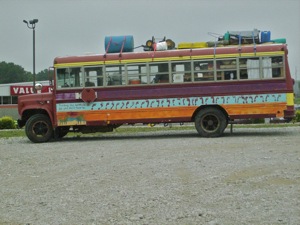
The text on the side of the bus reads: “Feeding the world so you don’t have to.” The designs on the light blue stripe on the side of the bus are footprints; above that in the purple strip are handprints. I could not make out what kind of equipment was tied to the roof of the bus; perhaps it was gardening equipment. Through the windows of the bus, I could see additional equipment. Unfortunately, there was no one around the bus whom I could ask.
(2) Signs at the junction of Interstate 44 and Missouri Route UU:
